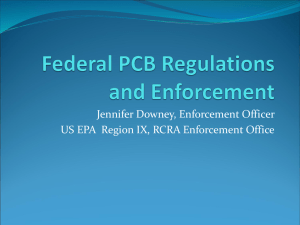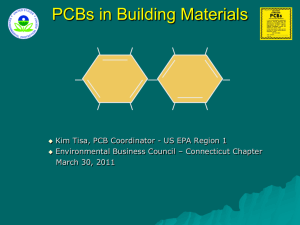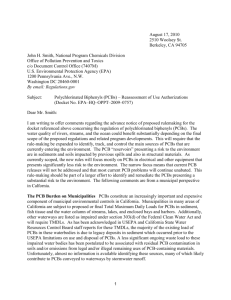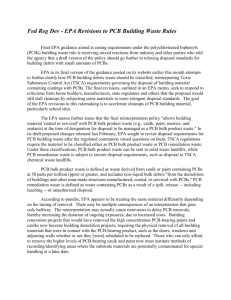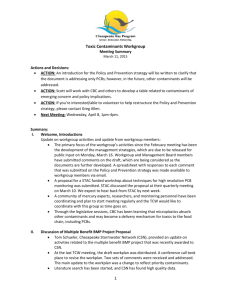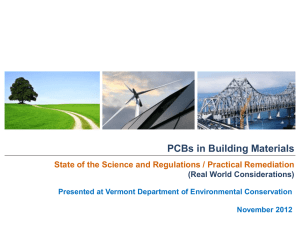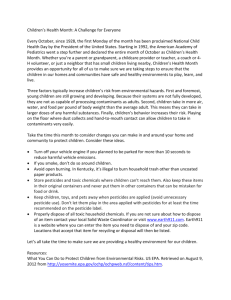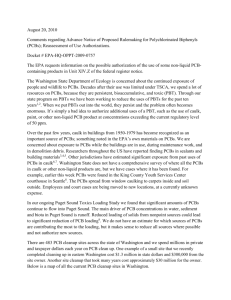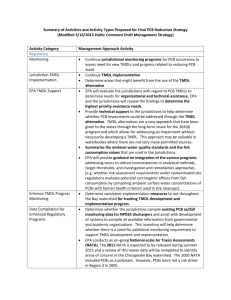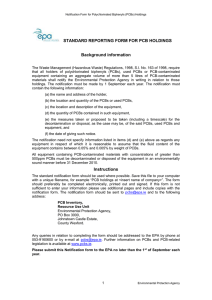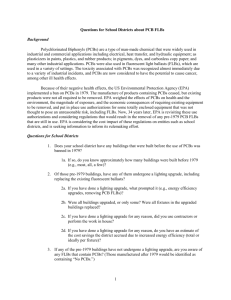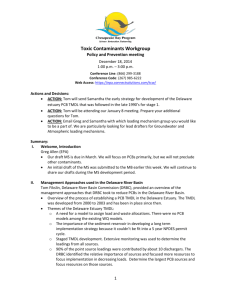Summary - Chesapeake Bay Program
advertisement
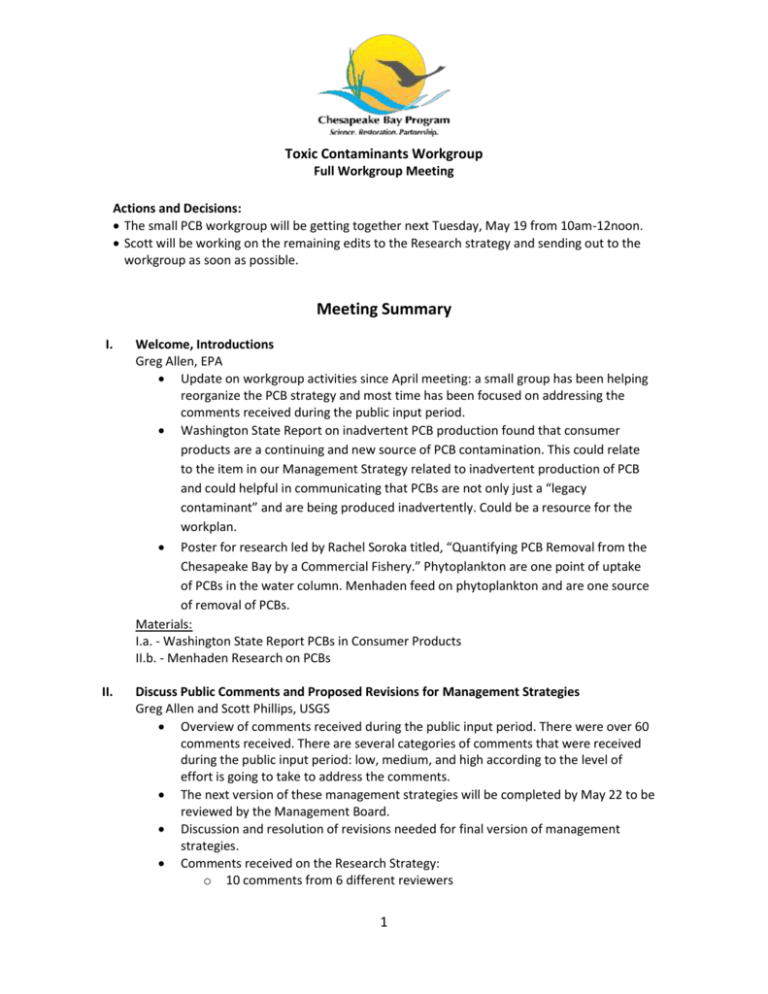
Toxic Contaminants Workgroup Full Workgroup Meeting Actions and Decisions: The small PCB workgroup will be getting together next Tuesday, May 19 from 10am-12noon. Scott will be working on the remaining edits to the Research strategy and sending out to the workgroup as soon as possible. Meeting Summary I. Welcome, Introductions Greg Allen, EPA Update on workgroup activities since April meeting: a small group has been helping reorganize the PCB strategy and most time has been focused on addressing the comments received during the public input period. Washington State Report on inadvertent PCB production found that consumer products are a continuing and new source of PCB contamination. This could relate to the item in our Management Strategy related to inadvertent production of PCB and could helpful in communicating that PCBs are not only just a “legacy contaminant” and are being produced inadvertently. Could be a resource for the workplan. Poster for research led by Rachel Soroka titled, “Quantifying PCB Removal from the Chesapeake Bay by a Commercial Fishery.” Phytoplankton are one point of uptake of PCBs in the water column. Menhaden feed on phytoplankton and are one source of removal of PCBs. Materials: I.a. - Washington State Report PCBs in Consumer Products II.b. - Menhaden Research on PCBs II. Discuss Public Comments and Proposed Revisions for Management Strategies Greg Allen and Scott Phillips, USGS Overview of comments received during the public input period. There were over 60 comments received. There are several categories of comments that were received during the public input period: low, medium, and high according to the level of effort is going to take to address the comments. The next version of these management strategies will be completed by May 22 to be reviewed by the Management Board. Discussion and resolution of revisions needed for final version of management strategies. Comments received on the Research Strategy: o 10 comments from 6 different reviewers 1 o Four major topics of comments: Additional issues of emerging concern (fracking, pesticides) Prioritizing based on relative risk Management practices (biosolids, WWTP) Better connection between research and PP strategies o Responses to Comments: Pesticides: already existing efforts for addressing the effect of pesticides on pollinators. There are more pressing research needs that will be addressed in this strategy. Fracking: already existing efforts of addressing this issue. Better prioritizing of the contaminants: PCBs and Hg are the highest risk contaminants that will be prioritized as we work on reducing comments. We need to consider which contaminants we will be prioritize next after PCBs and Hg. Biosolids as a source of EDCs: text will be modified. WWTP and removal of PCBs: text will be modified. Reflecting the science needs of the PP strategy in the Research strategy: the “science support” section of the PP strategy will be enhanced. Comments received on the Policy and Prevention Strategy: o 7 commenters submitted 60+ comments. o Topics of comments: Additional contaminants need to be addressed. Response: The intention is to first address PCBs and to move on to other contaminants as time goes on. Mercury is the next highest priority after PCBs. PCB WLAs in wastewater permits – non numeric WQBELs only. Response: “compliance limits” will be replaced with “permit requirements” Method 1668. Response: Having the right data is essential, but there are limitations due to lack of promulgation. The plan is to determine where it is being used now and where it needs to be used/how we can increase its use. Biosolids and stormwater solids are sources. Response: Be sure that the words are not presumptive. Clarify the purpose of the assessment of site cleanup risk criteria. Response: Refine the language to be sure the need and purpose are better described. Improvements to TMDLs. Response: These efforts could be useful in refining TMDLs and informing TMDLs still under development. TMDL alternatives could be considered. Feds should undertake a voluntary phase-out. Response: Discussions have started with FOD. How does having different WQS impact progress? Response: Remove this as a key factor. Materials: II.a. - Table of public comments for both research and Policy and Prevention Strategies II.b. - Summary of major review comments and approaches to address (Powerpoint) II.c. - Research Draft (Public Comment version, March 16) II.d. - Policy and Prevention draft (Public Comment version, March 16) II.e. - Management strategy timeline 2 III. Mercury - Recent Findings in the Bay Watershed John Sherwell, MD DNR; Mark Cohen, NOAA; Cindy Gilmour, SERC Overview of mercury monitoring data and trends in deposition and loading. Mark Cohen, NOAA Air Resources Laboratory, and Cindy Gilmour, Smithsonian Environmental Research Center, presented their research on mercury deposition around the world and in the Chesapeake Bay watershed. Some monitoring stations in the watershed show decreasing deposition but not all. This could be due to worldwide sources and/or a delay in response as the result of changing trends in coal use. Land use makes a difference in MeHg loads. Forests can accumulate dry-deposited Hg and has high organic content, which can result in more MeHg moving through. In ag lands the application of nitrogen sequesters the activity of sulfur-induced microbial generation of MeHg. Data gap is input at major river inputs to the Bay. A TMDL is in progress in Md and there has been useful source identification done for the Great Lakes that might be useful in the Chesapeake watershed. Materials: III.a. - John Sherwell PowerPoint III.b. - Mark Cohen PowerPoint III.c. - Cindy Gilmour PowerPoint 1 III.d. - Cindy Gilmour PowerPoint 2 III.e. - Cindy Gilmour PowerPoint 3 IV. Next Steps and Planning for May Meeting Scott Phillips, USGS Action: Small PCB workgroup will be getting together next Tuesday, May 19 from 10am12noon. Action: Scott will be working on the remaining edits to the Research strategy and sending out as soon as possible. Attendance: Len Schugam, MDE John Sherwell, MD DNR Mark Richards, VA DEQ Tom Barron, PA DEP Dave Montali, WV DEP Scott Phillips, USGS Greg Allen, EPA Mindy Ehrich, UMCES Diane McNally, EPA Angie Garcia, EPA Lorie Baker, EPA Jacqueline Guerry, EPA Robin Eisemann, EPA Fred Pinkney, FWS LJ Ingram, Chart, LLC. Nick Corso, AXYS Analytical Jamie Mitchell, HRSD 3 Lana Sindler, Wash COG Tanya Spano, Wash COG Upal Ghosh, UMBC Samantha Watterson, CRC John Schneider, DNRC Dinorah Dalmasy, MDE Jenny Gundersen, EPA Marel King, CBC Michelle Cocolis, Wash COG Cindy Johnson, VA DEQ Don Smith, VA DEQ Evelyn MacKnight, EPA Sherm Garrison, MD DNR Dev Murali, DDOE Andrew Heyes, UMCES Mark Cohen, NOAA Cindy Gilmour, SERC 4
